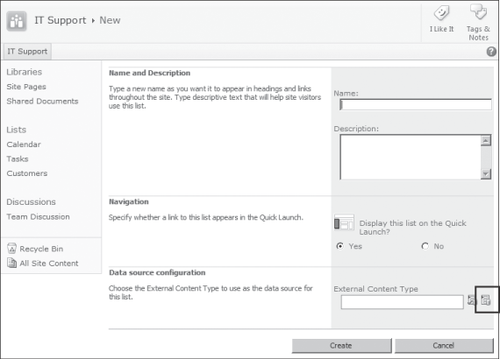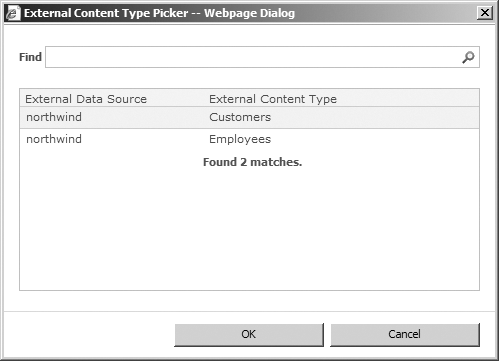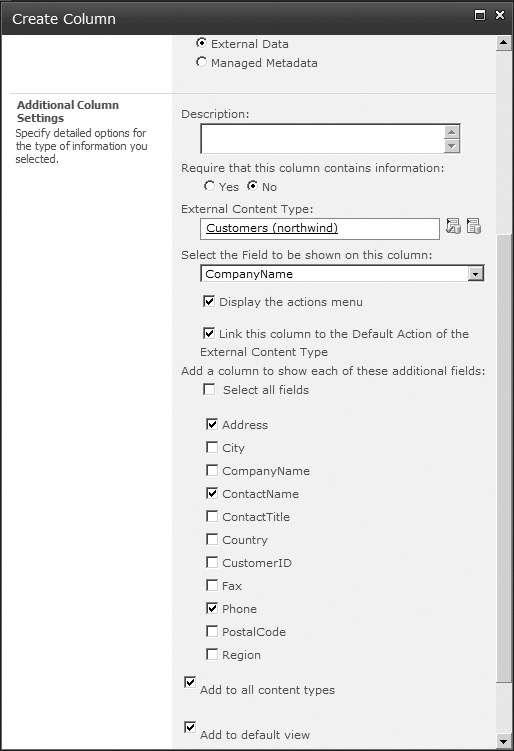Now that you have configured
the BCS application, created and imported BDC Models, and created
actions, building composite solutions and aggregating data from external
systems on dashboards is a relatively easy process, if you understand
your business data and the data users need to see. You can use the
browser or SharePoint Designer, or you can use External
Lists and External Data Columns, or if you have SharePoint 2010, you
can use the External Data Web Parts. You can then exploit the default
behavior of Web Parts, lists, and libraries, such as defining an
audience, targeting, filtering, and using Web Part connections.
1. External Lists
You create External Lists
using the browser, SharePoint Designer, Windows PowerShell, or code.
When you have created these lists, you will find that they have similar
functionally to other SharePoint lists you are familiar with; however,
you cannot associate RSS feeds to External Lists. There is also no
datasheet view, nor can you bind workflows to the data, because the data
is not in SharePoint, so you can’t trigger workflows on data changes.
However, using SharePoint Designer, you can create a site, list, or
reusable workflow that accesses one or more External Lists.
To create an External List using the browser, complete the following tasks.
Open the site where you want to create the External List.
Click Site Actions and then select More Options.
On the Create page, click External List.
Note:
If you have a large number of list types, you will find the External List option if you filter by List and Data categories.
On
the New page, enter the name and description of the list and then
select whether you want to create a link to this list in the Quick
Launch bar. To the right of the External Content Type text box, click the Select External Content Type icon, as shown in Figure 1.

The External Content Type Picker dialog box appears, as shown in Figure 2. Select the ECT, which defines the external system that you want to display in your External List, and then click OK.

On the New page, click Create.
2. Business Data Web Parts
SharePoint 2010 ships with seven generic external
data Web Parts, six of which are functionally the same as they were for
the Business Data Web Parts in SharePoint Server 2007. The seventh is a
new Web Part—the Chart Web Part. These Web Parts can be used to display
any ECT from the BCS without writing any code. After they are
configured, they will automatically be named after the entity data they
are displaying. The Web Parts that display data from the LOB systems
query the metadata cached on each Web front-end server, and then the
instance data is retrieved from the data source.
To use the Business Data Web
Parts on a site, you must activate the SharePoint Server Enterprise Site
Collection features at the site collection level.
3. External Data Columns
An External Data Column
allows you to add data from an ECT to a standard SharePoint list. In
SharePoint Server 2007, these were referred to as Business Data columns.
If an External Data Column is added to a document library, then they
can be made available as content controls in Word 2010.
To add a business data column to a list, complete the following tasks.
Navigate to the list or library where you want to add the column.
To
display the Ribbon, click List within List Tools and then click Create
Column in the Manage Views group to display the Create Column dialog
box.
In
the Name And Type section, enter a column name and select the External
Data type. This column type can hold any ECT. The dialog box redisplays,
and you will now see Check and Select ECT icons in the Additional
Column Settings section.
Click the Select External Content Type icon to display the External Content Type Picker dialog box, as shown in Figure 3.
Choose the appropriate ECT and click OK. The dialog box closes, and you
will see that the Additional Column Settings section contains a list of
properties associated with this entity, as shown in Figure 18-23.
From
the Select The Field To Be Shown On This Column drop-down list, select a
field and then click any related data you want to display. For example,
you might choose to display a customer’s name with the customer’s
business address and phone number. You can select the Add To All Content
Types option and the Add To Default View option to add the column and
additional fields to the default view.

Now when you add a new list item, you can use the External
Data Select icon to display the Choose External Data dialog box. Up to
this point, SharePoint 2010 used the BDC administrator object model to
retrieve the information from the cached metadata held in the Web
front-end server. When the list is displayed, the BDC runtime object
model connects to the external data source, and it copies the data into
the list, unlike the external data Web Parts, which contain only a link
to the external data. To update the data in the list, you can click the
Refresh icon to the right of the External Data Column name. A Web page
is displayed that warns you that this operation could take a long time.
If you click Yes, the data source is contacted to return the necessary
data. By copying the business data in the list, the business data within
the list has inherited all list type operations, such as view and
filter.